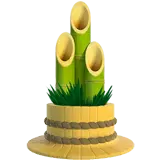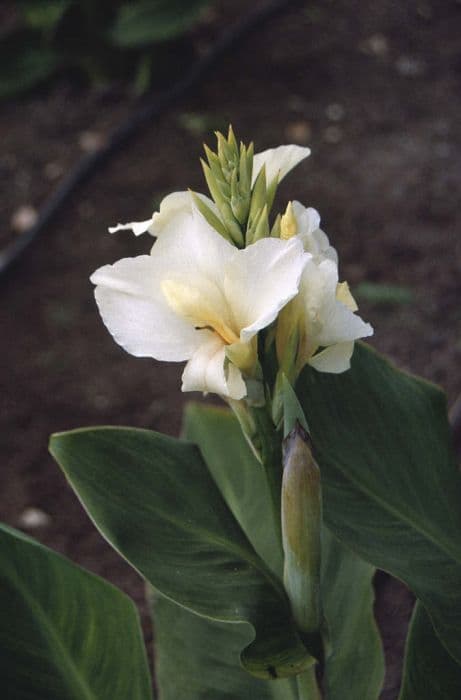Variegated Canna Canna 'Striata' (v)

ABOUT
The Canna 'Striata', also known as the Variegated Canna Lily, is a vibrant and striking plant admired for its lush foliage and showy flowers. This variety boasts broad, banana-like leaves that form a lush backdrop for its blooms. The leaves are particularly notable for their striking green and yellow striped pattern, which adds a dramatic contrast to the garden. In the warmth of summer months, the Canna 'Striata' produces tall spikes of flowers that are a magnet for hummingbirds and butterflies. They typically come in shades of orange, adding a fiery pop of color that complements the variegated foliage. These blossoms are shaped like flared trumpets and clustered along the stems, offering a tropical look to the plant display. Overall, the Canna 'Striata' carries a bold tropical flair with it, due to its combination of brightly striped foliage and spirited, vivid flowers. Its appearance can bring a lively accent to any garden setting, creating a focal point that draws the eye with its exotic charm.
About this plant
 Names
NamesFamily
Cannaceae.
Synonyms
Variegated Canna, Striped Canna Lily, Tropicanna Canna.
Common names
Canna 'Striata'.
 Toxicity
ToxicityTo humans
Canna indica, commonly known as Indian shot, is not known to be poisonous to humans. There are no well-documented reports of toxicity from consuming any part of the plant. It's always advisable to avoid eating ornamental plants or their parts unless they are confirmed to be edible.
To pets
Indian shot is not known to be toxic to pets. There is no significant evidence to suggest that pets, such as cats and dogs, will experience adverse effects from ingesting this plant. As with any non-food plant, ingestion might cause mild gastrointestinal upset simply due to the ingestion of non-digestible matter, but no serious toxicity is expected.
 Characteristics
CharacteristicsLife cycle
Perennials
Foliage type
Deciduous
Color of leaves
Variegated
Flower color
Mixed
Height
3-4 feet (0.9-1.2 meters)
Spread
1-2 feet (0.3-0.6 meters)
Plant type
Bulb
Hardiness zones
7-10
Native area
South America
Benefits
 General Benefits
General Benefits- Aesthetic Appeal - Adds vibrant color and exotic texture to gardens and landscapes with its striking green and yellow striped leaves and bright flowers.
- Low Maintenance - Requires minimal care once established, making it suitable for gardeners of all skill levels.
- Drought Tolerance - Can survive periods of low water, making it ideal for xeriscaping and water-wise gardening.
- Attracts Wildlife - The flowers attract hummingbirds and other pollinators, promoting biodiversity.
- Fast Growth - Rapid growth rate allows for quick filling in of garden spaces or pots.
- Edible Parts - Some parts of the plant, like the rhizomes, are edible when cooked, though they are not commonly consumed.
- Versatility - Suitable for planting in a variety of settings, including borders, garden beds, and containers.
 Medical Properties
Medical PropertiesThis plant is not used for medical purposes.
 Air-purifying Qualities
Air-purifying QualitiesThis plant is not specifically known for air purifying qualities.
 Other Uses
Other Uses- Canna 'Striata' foliage can be used as a natural dye, providing a range of colors depending on the mordant used.
- The large leaves are sometimes used as plates or wrappers for food in eco-friendly serving practices.
- The fibrous nature of the plant's stalks can be processed into paper or used in making biodegradable products.
- The seeds of Canna 'Striata' can be strung into jewelry or used as beads in artisanal crafts.
- The dried stalks of canna plants are used as support stakes in gardening for other, less sturdy plants.
- Canna 'Striata' can be incorporated into a living fence due to its dense foliage and fast-growing nature.
- The plant’s thick rhizomes can be carved into stamps for block printing or craft projects.
- Canna 'Striata' can be used in water gardens or ponds for their water-cleansing properties, trapping sediments and providing habitat.
- The flowers are sometimes used for natural confetti or as decorative elements in eco-friendly packing materials.
- When dried, the leaves can be woven into mats, hats, or other forms of sustainable handcrafts.
Interesting Facts
 Feng Shui
Feng ShuiThe Canna Lily is not used in Feng Shui practice.
 Zodiac Sign Compitability
Zodiac Sign CompitabilityThe Canna Lily is not used in astrology practice.
 Plant Symbolism
Plant Symbolism- Exotic Beauty: The Canna 'Striata', or Canna Lily, with its striking striped leaves and bold flowers, is often associated with exotic beauty and a showy appearance that catches the eye.
- Creativity: The bright and varied colors of the Canna Lily are symbolic of creativity and artistic flair, representing an individual’s unique expression.
- Confidence: As a plant that stands tall and blooms prominently, the Canna Lily can symbolize confidence and the ability to stand out in a crowd.
- Pride: The lush growth and vibrant presence of the Canna Lily may be tied to feelings of pride, either in a personal achievement or in cultural or national identity.
- Fertility and Abundance: With its rapid growth and prolific flowering, the Canna Lily can also signify fertility, prosperity, and an abundance of good fortune.
 Water
WaterVariegated Cannas should be watered deeply once a week, providing about 1 inch (approximately 0.6 gallons) of water to ensure the soil stays moist but not waterlogged. During hot, dry periods, increase watering to twice per week. Always check the top inch of soil for dryness before watering. If it's dry to the touch, it's time to water. Reduce watering frequency in the fall as the plant prepares for dormancy.
 Light
LightVariegated Cannas thrive in full sun conditions, requiring a minimum of six hours of direct sunlight daily. An ideal spot would be in an unobstructed southern or western exposure to ensure they receive ample light. If grown indoors, place them near a sunny window.
 Temperature
TemperatureVariegated Cannas prefer warm conditions and will thrive in temperatures between 60°F and 90°F. They should not be exposed to temperatures below 50°F, as they are not frost-tolerant. The ideal range for promoting growth is between 70°F and 85°F.
 Pruning
PruningPrune Variegated Cannas to remove spent blooms and damaged leaves to encourage new growth and improve appearance. This should be done throughout the growing season as needed. After the first frost, cut back the foliage to a few inches above the ground to prepare for winter.
 Cleaning
CleaningAs needed
 Soil
SoilThe best soil mix for Canna 'Striata', commonly known as variegated canna, should be rich, well-draining, and have a pH between 6.0 to 6.5. A mix of garden soil, compost, peat or coco coir, and perlite or sand is ideal, ensuring the soil remains moist but not waterlogged. Regularly adding organic matter can help maintain soil fertility.
 Repotting
RepottingVariegated cannas like Canna 'Striata' typically need to be repotted every 2-3 years or if they become pot-bound. It’s best to repot them in spring before the new growth starts, using a pot only slightly larger than the previous one to avoid excess soil moisture.
 Humidity & Misting
Humidity & MistingVariegated cannas thrive in moderate to high humidity levels. Ideal humidity for Canna 'Striata' ranges between 40% to 70%. They tolerate some dryness but benefit from occasional misting or a nearby humidifier if indoor air is too dry.
 Suitable locations
Suitable locationsIndoor
Place variegated canna in bright light, keep the soil moist.
Outdoor
Plant in full sun, moist soil, fertilize monthly in growth period.
Hardiness zone
7-11 USDA
 Life cycle
Life cycleCanna 'Striata', also known as Variegated Canna Lily, begins its life cycle as a dormant rhizome, which is typically planted in spring after the last frost. Once temperatures warm, the rhizome sprouts, sending up shoots and broad, striped leaves, characteristic of its variegated pattern. During late spring to early summer, Canna 'Striata' enters its flowering stage, producing tall stalks topped with vibrant flowers that can range in color, usually with a splash of yellow or red. The blooming period can last until late summer or fall, depending on the climate and care. After flowering, the plant sets seed pods, although Canna 'Striata' is often propagated by dividing the rhizomes rather than growing from seed. Once colder temperatures arrive, the plant dies back, and the rhizomes enter a period of dormancy over winter, ready to restart the cycle in the following spring.
 Propogation
PropogationPropogation time
Spring to Summer
The Canna 'Striata', or variegated canna lily, is most effectively propagated through division, which is typically done in the spring just before the new growing season begins. This process involves separating the rhizomes, which are the underground stems of the plant. Gardeners should carefully dig around the canna lily to lift the entire clump out of the ground, then use a sharp knife or spade to cut the rhizomes into sections, ensuring each section has at least one eye, or growth point. These sections can then be replanted in well-draining soil at a depth of about 4 inches (approximately 10 centimeters), allowing for each piece to develop into a new plant. Adequate spacing, usually around 1 to 2 feet (30 to 60 centimeters) apart, is important to give the new plants room to grow. The newly planted rhizomes should be watered well to establish them, and they will soon begin to grow, creating a fresh display of the plant's strikingly variegated foliage and vibrant flowers.








![Canna [Tropicanna Black]](/_next/image?url=https%3A%2F%2Fplants-admin.emdemapps.com%2Fimages%2Fplants%2F%2Fimages%2F604b5ba79b97e.png&w=640&q=75)
